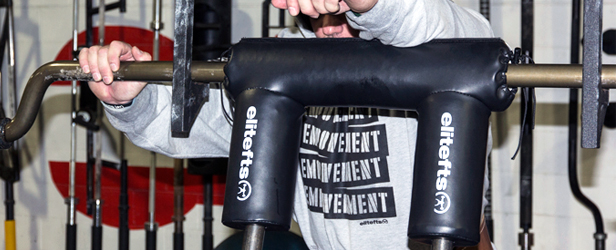
Soon after opening the Academy of Sports Performance (ASP), we invested in a number of specialty bars from elitefts™. One of these bars was a safety squat (yoke) bar. I’ve used one in the past, mainly as a variation for squatting maneuvers during my training for powerlifting. Typically, it was used for pause squats, box squats, and good mornings following the main lift of the day. I also used it for a number of months in place of normal squatting when I was dealing with a shoulder injury from rugby and had a hard time getting my shoulder in and out of position on a normal straight bar.
Since receiving ours, I’ve come to regard this bar as an indispensable tool in training both myself and our athletes. I wanted to compile a short list of the reasons why I feel this way and the different scenarios where this bar has shown its value in comparison to a traditional straight bar.
Beginners:
Most of the athletes we work with have never been exposed to any (much less proper) strength training. I consider squatting to be a basic movement pattern that everyone should learn and train in some form or another. When deciding which form of squatting would be best to teach an athlete, I place a high value on the amount of time it takes to teach the movement. In my opinion, it’s also easier to teach box squatting than free squatting (different argument for a different day), but one thing I’ve found that speeds up both is using the safety squat bar. Learning the movement quickly and safely is important to me because it allows my athletes to start practicing the correct motor patterns while they refine some of the finer points of the exercise. I’ve found that you can get just about anyone to squat to depth with good form within a couple sets when using the safety bar and good coaching cues.
Swimmers:
I’ve found particular value in using the bar with the swimmers we train. Due to the fact that they're classified as “overhead athletes” and spend a considerable amount of their glenohumeral tolerance on practicing and performing their strokes, I tend to program more “shoulder friendly” variations of the basic movement patterns. The safety squat bar definitely helps me meet this requirement.
Rugby players:
Coming from a rugby background, we have a good number of former and current players from my club team (Cincinnati Kelts) who train with us. I have yet to run into a rugby player with more than one year experience and healthy shoulders. While there are other ways to address fixing and protecting their shoulders, the safety squat bar allows me to avoid straining the joint any more in the way a straight bar would.
Volleyball players:
Aside from soccer players, volleyball athletes comprise the largest number of trainees in our gym. Much like the swimmers we train, they spend a considerable amount of time with their arms traveling overhead. Volleyball players receive a similar benefit as the swimmers by limiting the additional stress on their glenohumeral joint caused by the external rotation position used with a straight bar.
There is an additional benefit to using the safety squat bar with volleyball athletes. Because many of them are tall and slim, and due to the biomechanical demands of their sport and other external factors, I see many volleyball players who are in some stage of developing a spinal stress fracture (spondylolysis). Without any empirical data, it’s my opinion that using the safety squat bar helps to mitigate the internal risk factors for this injury by emphasizing the role of the spinal extensors during various movements. If you’ve ever used one, you know what I mean by this:
- My broken self: Having played contact sports for a good portion of my youth and adult life, I’m beat up. I've had lots of shoulder dislocations/subluxations and various back and knee injuries, leaving me feeling pretty rough on a daily basis. Using the safety squat bar for many movements, especially squatting and good mornings, has allowed me to spare my shoulders and low back while continuing to train hard for my current endeavor (powerlifting, getting stronger, and being awesome).
- Tall people: The other two trainers here at the gym are both freakishly tall individuals (six feet eight inches tall and seven feet tall) and as such, are naturally terrible squatters. Watching them flail about with weights gives me joy on a daily basis. At some point, these giraffes needed to learn to squat and maybe even get close to achieving parallel depth. All kidding aside, they've been working very hard to get their hips back and down with a straight bar, but as soon as they began squatting with the safety squat bar, their depth (and comfort at that depth) improved. I’m not sure if it’s the camber (shifting the load anterior relative to the COM like in a front squat, which I think also works well for tall individuals), the shoulder position, or something else, but if you're tall or work with tall athletes, I suggest giving it a shot.
In conclusion, after using this bar to train athletes for the past couple months, I can’t see how I could go without it. I’ve taught thousands of people to squat over the past decade (and I'm still learning myself), but I can easily say that this tool has been one of the most critical implements I’ve ever used in the process. It speeds up the teaching process; allows tall, skinny people to more easily hit depth; strengthens the spinal erectors; and spares the shoulders. If you have the resources, I highly suggest finding a way to incorporate this tool into your own training or that of your athletes.











1 Comment